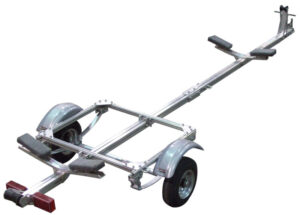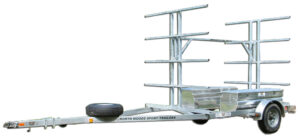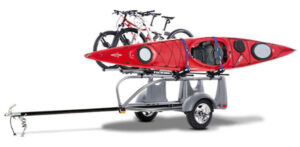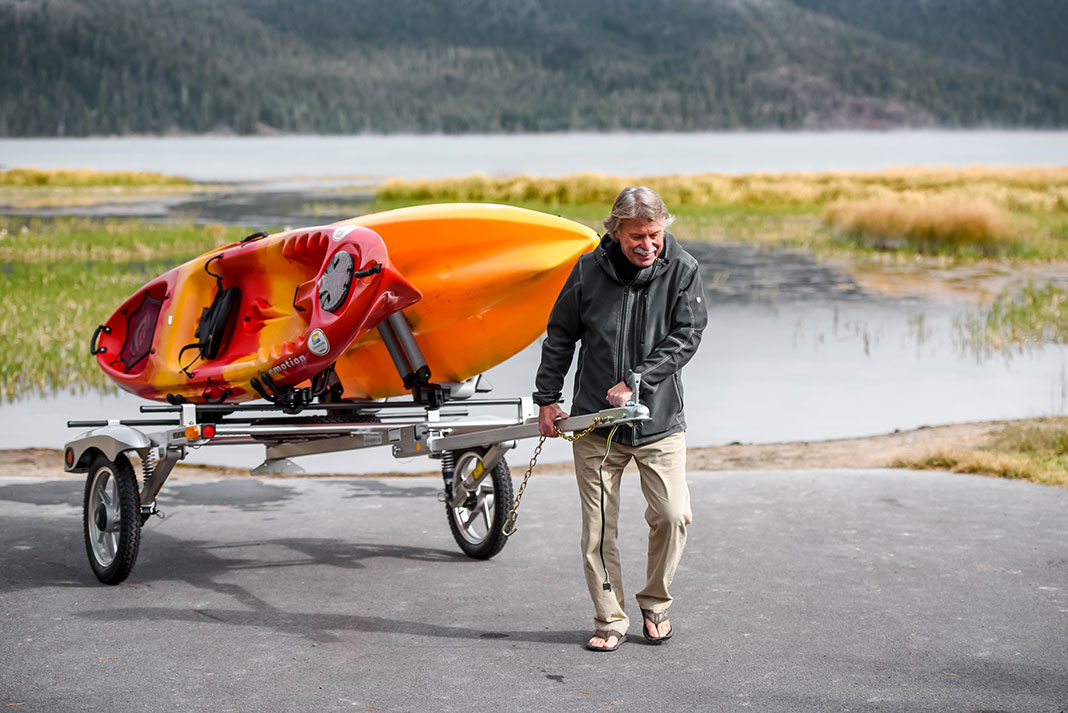Products You May Like
Like a kid the day before Christmas, you’re excited to get your new kayak on the water. You’ve done the research, dropped a sizable down payment and today’s the day to pick up your new ride. Until you try to pick up your new ride. Ugh. Oooph. Eeeeeyow. And, possibly, snap, crack and crunch.
Full-size, full-feature fishing kayaks can weigh over 100 pounds, measure more than 13 feet long and over three feet wide. Wrestling this boat onto your roof rack endangers the kayak, car and your body. Unless you’re a regular powerlifter, you’re likely to throw out your back. Plus, few roof racks are manufactured to withstand the leviathan load of one big fishing kayak, let alone two.
Other than maybe the back of a pickup, the best way to transport big fishing kayaks is with a trailer. A kayak trailer is not just easier and safer for your body and vehicle; it’s more efficient too. A kayak on a trailer is more aerodynamic than one riding on the roof as it’s hidden from the wind, saving fuel and reducing wear and tear on your car.
Choosing the Best Kayak Trailer
The trend towards ever-larger fishing kayaks has led to a boom in kayak trailers. Today there are a variety of sturdy trailers designed to transport kayaks and all the associated paddling and fishing gear.
At its most basic, a kayak trailer is just a rack on wheels towed behind a vehicle. Models come in different shapes and sizes—some are small and compact, while others feature multiple tiers and can transport upwards of half-a-dozen kayaks. Some trailers are designed to carry a combination of kayaks and other outdoor adventure gear, like surfboards, bikes and even pop-up tents. Some kayak trailers also boast a bed for gear storage, perfect for fishing and paddling gear.
The first question to ask yourself before buying a trailer is how many fishing kayaks do you need to transport regularly? Many anglers will be satisfied with a kayak trailer with space for just one or even two kayaks, but families and groups who paddle and fish together will want to look at multi-tiered models.
Most trailers are made from galvanized steel or aluminum. While aluminum trailers are lighter, they’re also more expensive. Be sure to check the trailer’s capacity guidelines. Heavy fishing kayaks may need heavy-duty trailers. Paddle shops and outdoor stores usually carry a couple of kayak trailer options, but anglers can also purchase the trailer online and assemble it themselves at home.
Keep in mind the weight of the whole unit—the best kayak trailer is light enough to push around in your driveway, even loaded with two kayaks.
5 Types of Kayak Trailers

1 Base Trailer
Trailex SUT-220-SA Express Assembly
$1,180 | trailex.com
Low frame with a simple design. An extending tongue connects two outer bars and two crossbars on top of an axle and wheels. Ta-da. It’s lightweight and easy to load and unload. Perfect for vehicles with a lower towing capacity.
2 Side by Side Trailer

Malone Ecolight 2 Kayak Trailer Package
$1,499 | maloneautoracks.com
A base trailer with a broader design can accommodate two kayaks lying flat side by side. Or add cradles and carry up to four kayaks on their sides. The heavier the load, the more hauling power your vehicle needs.
3 Stacked Trailer

North Woods Sport Trailers 8 Place Trailer
Typically, trailers with multiple tiers of racks are used by outfitters, clubs and manufacturers for delivering kayaks. These usually feature a reinforced elevated frame and larger wheels. Often these are custom builds doubling as utility trailers with removable kayaks trees.
4 Multi-Sport Trailer

SylvanSport Go Easy
$2,295 | sylvansport.com
This versatile category includes trailers designed to carry all sorts of outdoor gear, including bikes, SUPs and your fishing kayak. Often they’re customizable. Perfect for families and friends on all sorts of adventures.
5 Folding Kayak Trailer
Some trailers are designed to fold and even be stored upright. This is ideal for anglers with limited storage space.
How to Transport Your Fishing Kayak
Each placement for a kayak on a trailer will have two crossbars, just like on a roof rack. To transport the kayak, an angler has two options:
One is to empty the kayak of gear, accessories and seat, turn it upside down, lift it onto the racks and lash it to the crossbars with cam straps or ropes. Upside-down they typically sit flatter on the deck and tightening straps and ropes doesn’t crush the hull. Hatches and fixed mounts sometimes get in the way of the bars.
The other option is to transport the kayak upright without removing the seat and all the accessories. This allows the angler to get on the water faster at the launch, without fussing with setting up everything, every time. However, to properly support and secure an upright kayak in transit, you’ll need to add a set of kayak saddles or shaped foam blocks to cradle the hull on the crossbars. Ensure the saddles are designed to accommodate your size and style of crossbar before purchase. Then take the time to adjust placement and angle to fit the wide beam and shape of your fishing kayak hull.
Mind Your Tongue
The tongue is the long part of the trailer extending to your vehicle. Kayak trailers often have a longer tongue than a conventional utility trailer so the kayak won’t hit the vehicle when turning. This is an important aspect to keep in mind for any angler who wants to make a DIY kayak trailer from a standard utility trailer. Shorter kayaks can be transported on trailers with conventional length tongues, but kayaks longer than about 10 feet may require the extended tongues standard on dedicated kayak or canoe trailers.
How to Use a Kayak Trailer
To load a kayak trailer, start with the trailer hooked up and secured to the hitch on the vehicle. Then, line the kayak up parallel behind the trailer, facing forward—a kayak should never point backwards, that’s just weird. Next, lift the kayak’s bow and place it onto the rear saddles or crossbar. Then, lift the kayak’s stern so you can push and slide the boat forward onto the trailer centering it front to back in the cradles.
If your trailer is uncomfortably high, aftermarket accessories will help. Using accessories like a hydraulic lift-assist can essentially half the amount of weight lifted.
Once the kayak is on the trailer’s racks, use cam straps or ropes and a trucker’s hitch knot to secure it. Give the kayak a good shake to ensure it is fastened securely.
This article was first published in Issue 66 of Paddling Magazine. Subscribe to Paddling Magazine’s print and digital editions, or browse the archives.
Transporting your fishing kayak on a trailer is smarter, easier and safer. Your car, kayak and back will thank you. | Feature photo: Courtesy Yakima
